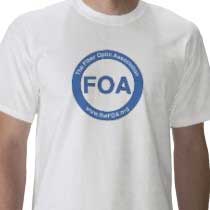The FOA
Update Page covers all the new technology and
applications we covered in this newsletter in 2018-19. Now you
can review all that new tech at once.
The FOA
Fiber FAQs Page (FAQs = frequently asked questions)
gathers up questions readers have asked us (which first ran
in this newsletter) and adds tech topics of general
interest.
This
months "Good Questions" has some unique
questions from our readers.
Fiber
Optic Cable Plant - The Finished Product
This month,
FOA has received inquiries from several sources that all deal
with the same subject - what is involved in the specification
and acceptance of a cable plant at the end of a installation
project. And what are reasonable specifications for a cable
plant.
FOA has a lot of documentation on a project involving
designing and installing a cable plant in the FOA Online Guide
and our Textbooks, but the acceptance process is relegated to a
few paragraphs. Let's look at a project and include a few links
to FOA tech documents in case you want to investigate further.
The Project "Deliverables"
Fiber optic projects start with a design
that creates project
paperwork - the scope of work (SOW), request for proposal
or quote (RFP/Q) and a contract with the builder/installer. A
"Scope of Work" document is created by the initiator of a
project to describe the work to be performed or the services to
be provided by a contractor. It describes tasks to be performed,
directs methods to be used, and defines the period of
performance. It should contain design and performance
requirements. A scope of work for communications cabling or
fiber optics may be part of a larger building project document
that is based on a standardized format called "MasterFormat"
in the US and Canada.
A well written scope of work can do more for the success of a
contract than any other part of the contracting process. A good
scope of work is clear, complete, and logical enough to be
understood by the respondent and the university personnel who
will administer it. Because it describes the details of
performance, it is the yardstick against which the respondent's
performance is measured. That is why the user's requester,
contract administrator and/or subject matter expert should be
the focal point for developing the scope of work.
What we are discussing here is the final product - the
"deliverables" - that define the final product that the end user
expects to have when the installation is complete and ready to
use, or in some cases already has the communications equipment
installed and operating. Of course the deliverables include the
physical cable plant, but also must include full documentation
and test results, and maybe even a warranty.
Cable Plant Specifications
What are reasonable specifications for a cable plant. We've
often heard stories of specs that are too stringent and others
too lax. Since specifications for the installed cable plant are
up to the person specifying the cable plant, they may be
confusing because very few standards exist for the design and
specification of the cable plant. OSP networks have
traditionally been specified and owned by sophisticated users
who have a history of what specs can be expected. Premises
cabling systems tend to use component specs from TIA or ISO/IEC
standards that are generally too lax, much higher than what
should be expected.
Let's do the executive summary. The cable plant should be
specified for loss using a loss budget. Network speed may
dictate specifications for component types or bandwidth. Here is
a summary of FOA's "reasonable specs" to use for cable plant
loss budgets. Below we'll get into testing with loss budgets
based on those specs.
OSP
Fiber: G.652 attenuation 0.4dB/km at 1310nm, 0.25dB/km @ 1550nm
Splices: Average 0.1dB, reject @ 0.2dB
Connections: Average
loss 0.3dB, reject @ 0.5dB, Reflectance better than -40dB.
Long haul fibers like G.654 will have slightly better
attenuation specs, ~0.2dB/km.
Premises
Fiber:
Multimode OM3/OM4 attenuation 3dB/km @ 850nm, Bend
insensitive fibers
Singlemode
OS1/OS2 attenuation
0.5dB/km @ 1310nm, Bend
insensitive fibers
Splices: Average 0.3dB, rare in premises
Connections: Average
loss 0.5dB, SM reflectance better than -40dB.
Cables, of course, are specified according to the
requirements of the project and it's physical
locations.
Documentation
The final documentation delivered to the customer must be
comprehensive, with full route information including GIS
(geographic information system) data on the location of the
cable and every component - cables, manholes/handholes, splice
locations and full descriptions, plus test data. The physical
component and location information is obvious, but what is not
is test data, which we elaborate on below.
What's sometimes missing, based on inquiries we get from end
users, is understandable documentation. Managers who may not be
familiar with fiber optics can be given reams of documentation
which they are expected to use to sign off on a project. There
are many stories about problems at this stage: signing off on a
data center installation where all 4,000 connectors were
failures, getting test data on a OSP network where every OTDR
test was the same, you get the idea. Before signing off on a
project, someone who knows fiber optics and was involved in the
project should review the documentation and test data and verify
that it is correct and valid.
Cable Plant Test Data
To prove the cable plant was installed properly requires test
data, of course. During the design phase, loss budgets
calculated for each cable run should provide an estimate of the
expected loss of the fibers in each cable link to compare to
actual test results.
Short fiber
optic premises cabling networks are generally
tested in three ways, connector inspection/cleaning with a
microscope, insertion loss testing with a light source and power
meter or optical loss test set, and polarity data, meaning that
the routing of fibers is confirmed so that when connecting
equipment the tech can identify fiber pairs for transmit and
receive. Polarity testing generally can be done with a visual
fault locator to confirm that fibers are connected per the
documented cable diagrams.
Outside plant (OSP) testing is more complex. If the cable plant
includes cables concatenated with splices, it's expected to add
OTDR testing to the connector inspection, insertion loss and
polarity testing. If the link has passive devices like FTTH
splitters or WDMs, those need to be tested and documented also.
There is one thing that whoever is reviewing the data - and
going back to the design phase, whoever writes the test
specifications based on the loss budgets in the first place -
needs to understand: none of these are absolute numbers.
The loss budget which is created early in the design
phase estimates the loss of the cable plant based
on estimates of component loss and therefore is
not an absolute number, but an estimate to be
used to compare to test data.
Test data is created by instruments and related components that
make measurements which have measurement errors.
There are always factors in making measurements that cause
the instrument reading to be inaccurate - only an
approximation of the real value - and the real value is
unknowable because of measurement errors. (If you are curious,
look up the Heisenberg uncertainty principle.)
Let's
look at this symbolically:
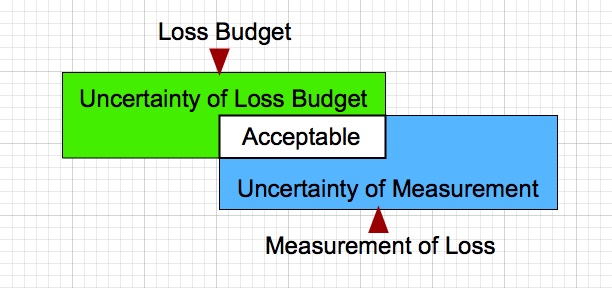
The loss budget is not exact, nor is the testing, so
there is a range of measurements that should be
acceptable. Some judgement is needed to determine if a
particular fiber is acceptable.
In our experience, those two factors cause more stress between
managers and installers than just about any other factor in a cable
plant project. Consider these examples of the issues with loss
budgets and testing errors.
OSP Cable Plant
Here is the situation a CFOT found themselves in when they
called the FOA. They were an 30+ year experienced splicer with
a half-million splices of experience. A customer wanted to
specify a long cable plant (~50 miles/80km) with splices that
averaged 0.05dB and any splices above 0.15dB was not
acceptable. Testing of the splice loss would be done with an
OTDR with bidirectional measurements and averaged.
What
made this call particularly interesting is this tech had some
real world data, the kind you do not see often. On a past job,
he had spliced a ~60 mile (100km) 288 fiber cable plant at 18
splice locations, that's 5,184 splices. His test records
showed that 60% of the splices were in the range of 0.02 to
0.08dB and 40% were in the range of 0.08 to 0.15dB. Only 17
splices were over 0.15dB.

The
customer noted that the
manufacturer
of the splicer used by the tech quoted a splice loss
capability of 0.02dB, so a field spec of 2.5 times that should
be easily achievable in the field. What the customer did not
understand was that 0.02dB
spec for the splicer was data taken in a laboratory on a
new or perfectly set up machine. The splices were made by
breaking a fiber and splicing it back together. Every
splice used in determining the splicer capability used
identical fibers - they were the same fiber.
In the field, when splicing cables together, the
environment is not like a lab. Machines are used to splice
thousands of fibers. The fibers in the cable can be from
numerous production runs and will have variations in mode
field diameter (MFD) and geometry. Assuming a long haul
network like this one is using G.654 fiber, we can look at
the ITU standard for G.654 fibers and we find these
specifications:
Mode Field Diameter: 9.5-10.5microns
Core Concentricity Errors: 0.8micron
That variation in fiber geometry and MFD can produce a
real difference in splice loss that will be directional.
That difference can be 0.05 to 0.1dB. That is independent
of how well the splicer can align and fuse fibers. Even if
aligned perfectly
and spliced perfectly
the differences in the fiber will cause directional splice
differences - higher in one direction, lower in the other.
The can be a 0.20 to 0.25dB difference in directional
splice loss when measured by an OTDR
caused by MFD variation in the fibers
(data from Corning ap note AN3060). This is something
which many techs are familiar with, but that method of
bi-directional testing merely removes the OTDR scattering
error and gives the average of loss from each direction.
It can't compensate for the actual directional splice loss
caused by the difference in MFD. Let's repeat that:
Bi-directional OTDR testing removes the OTDR error caused
by differences in fiber MFD or backscattering, but cannot
compensate for the actual directional difference in
splice loss caused by the difference in MFD.
Back to the customer's spec. They wanted an average splice
loss of 0.05dB and no splices over 0.15dB - which was
unacceptable. Using some math, we can analyze the data the
tech had from the prior 60 mile (100km) job. The average
splice loss on that cable plant was ~0.07dB. And only 17
were larger than 0.15dB, so the reject rate would have
been 0.3%.
If we compare the results of that job to the specs the
customer wants on the new job, the difference would be
0.02dB/splice at 18 splice points. The total loss
difference in the 60
mile (100km) cable plant would be 0.02dB X 18 or
0.36dB - and that is on a
60 mile (100km) run where the fiber loss
is 0.20dB/km X 100km or 20dB. And the loss
of the original 18 splices was only
~1.33dB! The difference is negligible and
the measurement uncertainty of the OTDR
test of end-to-end loss is much bigger
than the difference.
Premises Network
In premises fiber optic networks, the TIA standards allow for
connections to have a loss of 0.75dB - that is two connectors
mated to create a connection. A
fiber optic connector has no loss, per se, because it is
not being used. When in use, it is mated to another
connector creating a joint between two fibers, and that
joint is what has loss - a "connection" loss.
That number has been in the standards for at
least 30 years, but even then typical connectors with ceramic
ferrules were much better than that. That 0.75 dB loss was
needed for early connectors like SMAs and Biconics, so it
became the standard, Later, although everyone knew that the
typical ST, SC, FC and then LC connector was much better, the
industry saw the introduction of array connectors (MPOs) where
the 0.75 dB loss was needed, so rather than have different
values for single fiber and array connectors, it was left at
0.75dB.

If you do a loss budget for a premises network with an
intermediate patch panel like the one above, your loss budget
would include 4 connection losses, the two in the patch panel
and the ones in the outlets at each end where you connect the
patchcords to the LAN gear. The 4 connection losses using the
TIA model would allow a loss budget for connections of 4 X
0.75dB = 3.0dB. But if typical connections
are less than 0.5dB, you could have 3 connections
at 0.5dB and 1 connections
could be 1.5dB. If you had good connections
of 0.3dB, that fourth connection
could be 2.1dB!
When we look at fiber losses, TIA allows fiber
losses of 3.0 to 3.5dB/km at 850nm for
multimode fiber. Actual fiber is now less than
3dB/km, but since links are typically short,
~100meters, the error due to fiber being
better than the standard is only tenths of a
dB. That is too small to matter.
If our link above is 100m, the loss budget
using TIA numbers would be:
Fiber 0.1km X 3.0dB/km = 0.3dB
Connectors 4x 0.75dB = 3.0dB
Link Loss Budget = 3.3dB
With more realistic numbers, say 0.5dB connections, it would
be:
Fiber
0.1km X 3.0dB/km = 0.3dB
Connectors 4x 0.5dB = 2.0dB
Link Loss Budget = 2.3dB
And with really good connections,
say 0.2dB:
Fiber
0.1km X 3.0dB/km =
0.3dB
Connectors 4x
0.2dB = 0.8dB
Link Loss Budget =
1.1dB
That's a 2.2dB difference in a 100m
multimode network; that's a big
uncertainty! What would we choose for a
GO/NO-GO loss? Our judgement would be the
link should be under 2.3dB
Now
what happens when we test this link?
We use a LED test source at ~850nm, a meter calibrated at
850nm reading in dB, and two reference cables to make a
double-ended test. In a short link like this the cause of
measurement uncertainty is the loss of the connections.
Variations in modal fill from the test source and launch cable
can result in 0.2dB variations, which has resulted in an
international standard for mode fill, called "encircled flux"
which most multimode test sources today meet, but early
sources are unknowns and add to the uncertainty, The launch
and receive cables also add to the uncertainty, since fiber
standards allow up to +/-5% variation in core size, which can
cause loss variations at connections depending on the
direction of the light.
There are so many variables in making an insertion loss test
of multimode fiber that they fill a giant table in the FOA
page on "metrology" or the science of fiber optic
measurements. The generally accepted number for uncertainty of
this kind of measurement is ~0.2 to 0.5dB.
So exactly what is a acceptable test result for this fiber
link? If we measure a loss of 1.5dB, no question it passes. If
it measures 3.5dB, that's certainly a problem. But what if it
measures 2.5dB? That's 0.2dB higher than the loss budget
estimate we used, but we know the measurement is uncertain by
+/-0.2
to 0.5dB, and 2.3dB is within the uncertainty of the
measurement. It's probably OK.
Why
Would You Want A "Hollow Core" Fiber?
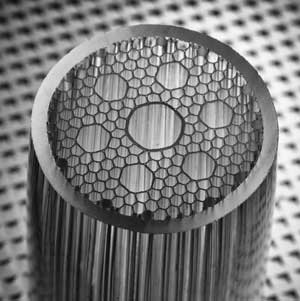
OFS Hollow Core Fiber Preform
OFS has just introduced AccuCore HCF Optical Fiber Cable, the
world's first terrestrial hollow-core fiber (HCF) cable
solution.
Why?
Fiber optics is often described as "sending signals at the
speed of light." But typical fibers are made of glass with an
index of refraction of ~1.5, so light travels at the speed of
light in a vacuum, c, divided by the index of refraction of
the medium it is traveling in, here 1.5, or c/1.5 = 0.67c -
2/3 the speed of light in a vacuum. That's about the same
speed as electrons travel in twisted pair cables and much
slower than in coax cables where the speed approaches 0.9c.
So why hollow core fibers? Latency.
Light travels about 50% faster in a hollow core compared to a
solid silica core of conventional optical fiber. Consequently,
light transmitted in a hollow-core fiber arrives 1.54
microseconds faster for each kilometer traveled compared with
conventional optical fiber.
The AccuCore HCF Optical Fiber Cable solution is based on
proven hollow-core fiber technology and includes
indoor/outdoor cable and termination with standard connectors,
which are fusion spliced to the patented photonic bandgap
hollow-core fiber. OFS also offers installation services and
both passive and active component selection to meet customer
requirements. AccuCore HCF optical fiber cable has been
successfully deployed, carrying live traffic in several
networks. Read the press release here.
Applications include:
High-frequency trading
High-performance computing
5G X-haul mobile networks
Intra-data center interconnection
Read
more.
When Is
A Dust Cap Not Filled With Dust?
When it's a
"CleanAdvantage(tm)" cap on a Corning Edge(tm) factory
terminated cabling system.
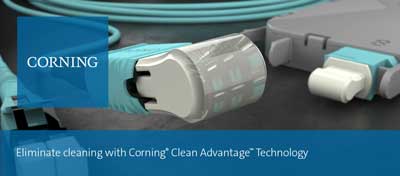
"Corning
understands the value of clean connectors to ensure optical
performance. So much so that we have developed a new factory
cleaning and sealing process, Corning® CleanAdvantage™
technology, to ensure a pristine end face upon first use for
all our EDGE™and EDGE8® solutions.
Thus, saving you as the installer time and money during the
initial installation. So go ahead and uncap that
CleanAdvantage connector so that you can connect with
confidence."
Read
More.
Don't
miss this Corning trivia about fiber - 3 times stronger
than steel.
Innovative
Microscope Awarded US Patent
Ed Forrest
of Fiber
Optic Precision Cleaning has been granted US Patent No.
10578847 for his innovative widefield microscope for fiber optic
connector inspection. Unlike other fiber optic microscopes that
closely inspect the end of the connector ferrule, this
microscope looks at the whole ferrule and the receptacle to
determine what else is dirty besides the end of the ferrule.
Dirt in the connector body is often the source of the dirt on
the end of the ferrrule, so it needs cleaning also. This
microscope should, of course, be used in conjunction with a
normal 100-400X inspection microscope.

Fiber
Optic Precision Cleaning also offers several excellent
books, whitepapers training on fiber optic connector inspection
and cleaning.
Is
There A Standard For Fiber Optic Installation?
Another
question we get often is "Is there a standard for fiber optic
installation." The answer is yes, but not from the usual
standards groups you might think about. Over 20 years ago, the
National Electrical Contractors Association (NECA) asked FOA to
help create a standard for installation. That standard,
ANSI/NECA/FOA-301 has been updated three times already and is
about ready for another update.
Unlike most of those groups who charge you a fortune for
standards, FOA covers the cost so ANSI/NECA/FOA-301
is available free from FOA.

Download
your free copy of ANSI/NECA/FOA-301
here (PDF)
More Questions and Answers from our
readers below.
Safety
Leader Magazine
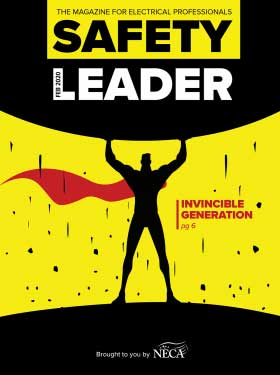
Safety Leader, a new quarterly magazine, informs and educates
electrical contractors on safety from various angles—electrical,
workplace, PPE, regulations, leadership, line work, NFPA 70E,
and more. Safety Leader is bundled with ELECTRICAL CONTRACTOR in
February, May, August and November. To receive Safety Leader subscribe
to ELECTRICAL CONTRACTOR magazine here or subscribe
to the ELECTRICAL CONTRACTOR newsletter here.
Conference
On Damage Prevention Cancelled But Goes Online

CGA
811 Excavation Safety Conference & Expo, the
premiere international event in the damage prevention
industry, was supposed to be March 24-26 but was cancelled
due to the coronovirus. Next year's program will be in
Tampa.
FOA was supposed to participate with a talk about New
Installation Techniques For Fiber Optics and participate in
a panel with members of the North
American Telecom Damage Prevention Council to discuss
the issue of protection fiber infrastructure from damage.
The conference organizers are having a several "Digital Days
of Education" so hopefully you can soon watch the sessions
online.
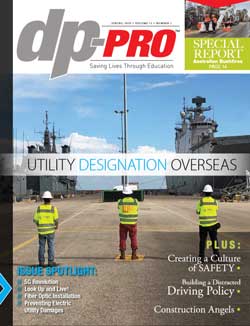
The magazine, dp-Pro, sponsor of the conference, has also
published it's latest issue with an article by FOA on "New
Construction Techniques in Fiber Optics" and a overview of
the FOA. You
can read the magazine here.
Bend
Radius (Quick Tutorial)
All
fiber optic cables have specifications that must not be
exceeded during installation to prevent irreparable damage
to the cable. This includes pulling tension, minimum bend
radius and crush loads. Installers must understand these
specifications and know how to pull cables without damaging
them.
The normal
recommendation for fiber optic cable bend radius is the minimum
bend radius under tension during pulling is 20 times the
diameter of the cable. When not under tension, the minimum
recommended long term bend radius is 10 times the cable
diameter.
Note: Always check the cable specifications for cables you are
installing as some cables such as the high fiber count cables
have different bend radius specifications from regular cables!
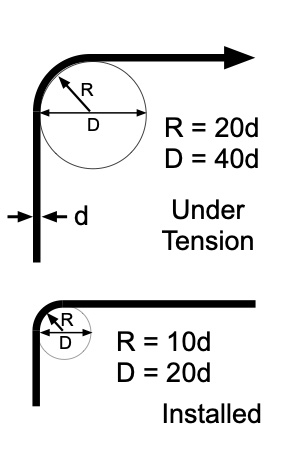
Under
tension (top) and after pulling (bottom)
Bend radius example: A cable 13mm (0.5") diameter would have a
minimum bend radius under tension of 20 X 13mm = 260mm (20 x
0.5" = 10") That means if you are pulling this cable over a
pulley, that pulley should have a minimum radius of 260mm/10" or
a diameter of 520mm/20" - don't get radius and diameter mixed
up!
Why
is it important? Not following bend radius guidelines can lead
to cable damage. If the cable is damaged in installation, the
manufacturer's warranty is voided. Here is what one
manufacturer's warranty says: "This
warranty does not apply to normal wear and tear or damage
caused by negligence, lack
of maintenance, accident, abnormal operation, improper
installation or service, unauthorized repair, fire,
floods, and acts of God." And their specifications call
our the minimum bend radius as "20 X OD-Installation, 10 X
OD-In-Service."
Some
FOA Founders Still Active
Recognize
Anybody Here? This
is the FOA Board of Advisors 20 years ago, meeting to work on
FOA certifications.
Those listed below in BOLD are still active teaching and
working with FOA.

Who Were The FOA Founders?
Jim Hayes, President of FOTEC Inc. Pioneering fiber optic
entrepreneur in test equipment and trainer who was trained in
physics/astronomy. Author of many EIA/TIA standards and the
instigator of the NBS/NIST fiber optic calibration program.
Creator of the Fiber U training conferences. Author of ten
textbooks, hundreds of technical articles. Current FOA
President.
Eric Pearson, Pearson Technologies. Trained by Corning in
the 1970s, considered an industry expert on termination and
splicing, training since the early 1980s. Active FOA
Instructor.
Dominick Tambone, Engineer, Automatic Tool and Connector, fiber
optic termination and installation, training since the early
1980s. Contractor and Active
FOA Instructor.
Bill Graham, Mississauga Training
Associates, Toronto, ON, CN. Background in utilities, military,
metropolitan fiber optics, training since the early 1990s. Current
FOA Director.
Prof. Elias Awad, Wentworth Institute, Boston, MA. Started one
of the first fiber optic academic programs in the engineering
department in late 1980s. Creator of NSF program “Fiber Optics
For Engineering Technology” (NSF#9353997).
Prof. John Highhouse, Lincoln Trail College, Robinson, IL. Head
of telecom training program, started teaching fiber optic
outside plant construction in late 1980s. Masters in Education,
specialty testing.
Paul
Rosenberg, writer and technical trainer
Dan Silver, Product Specialist, 3M Fiber Optics, trainer and
applications. The man with the idea to create the Fiber U
training conferences and active FOA member.
Eric Loytty, Field Engineering, Corning/Siecor, applications and
training.
Bob Mason, Product Manager, Network Systems, Panduit,
applications and training.
Doug Elliott, IBEW Instructor, Toronto, ON, CN. One of first
IBEW apprenticeship instructors to teach fiber optics.
Tom Collins, Northern Kentucky Technical College,
Professor. Techtricians, Owner/instructor. Current FOA
Director.
Dan Lyall, Project Engineer, Lockheed Martin, applications and
training.
James H. (Jim) Davis, Program Director, Navsea 56ZC, Navy fiber
optic standards.
Dave Chaney, Disney, Network Manager
Tony Beam, Tyco/AMP, Product Manager
Richard J. Smith, FOTechnologies, Technican/Instructor
Trevor Conquest, Conquest Communications, Brisbane,
Australia, fiber optic training.
Training
In The Frozen North
Bill Graham (lower left above with the white beard) lives near
Toronto and has probably trained half of Canada in fiber optics.
Bill sold his company, Missisauga Training, several years ago to
another active Canadian who
took over the training but Bill is still active as a FOA
Director and promoter in Canada. Bill is famous for training in
the Frozen North, still in competition with Ian Gordon Fudge of
Fiber DK in Denmark to see who has trained closer to the North
Pole. Bill always sent us photos from his trips, like these:
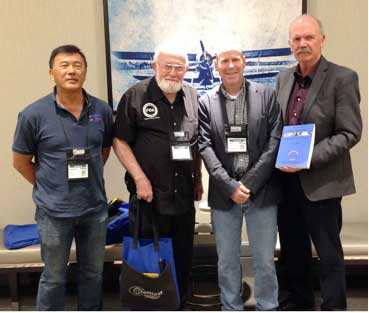
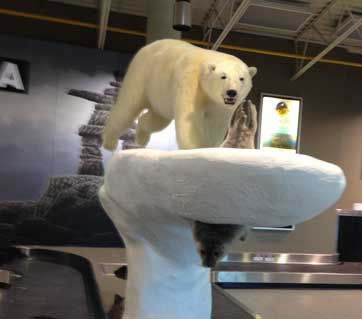
Netcom Training and maybe one of Bill's students near the Arctic
Circle
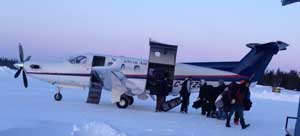
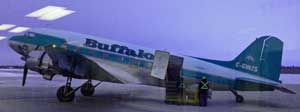
And yes, getting there was half the fun. That plane on the
right is a DC-3, probably more than 70 years old!
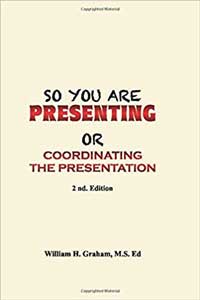
Bill is also an expert speaker, first a learning
from Toastmasters
and
then becoming a leader of the organization. He's written a short
guide for speakers that we recommend to everyone who has to get
up before a crowd and speak. You
can get "So You Are Presenting" by Bill Graham on Amazon.
FOA
will be 25 years old in July - watch for more articles on FOA
history.
Worth
Reading - News Summary
Each
month we read hundreds of newsletters and online articles.
These are the ones we think you will find "worth reading."
ISPs
Raise Speeds and Suspend Data Caps in Response to the
Coronavirus Pandemic - Consumer Reports.
Coronavirus
School Closings Expose Digital Divide - US News
Understanding
The True State Of Connectivity In America - 65% of US
counties receive broadband speeds below industry reports.
CityFibre
closes FibreNation acquisition - UK - The addition
of the new fiber assets has led CityFibre to raise its fiber
to the premises (FTTP) deployment plans from 5 million to as
many as to 8 million premises. From Lightwave.
Why
Businesses Need Fiber Connectivity, from Spectrum CATV.
Yes, it's a sales pitch, but they make good points and it
indicates they are serious.
DIRT
Report On Damage To Utilities
Common Ground Alliance (CGA) annual DIRT report provides a
summary and analysis of the events submitted into CGA’s Damage
Information Reporting Tool (DIRT) for the year 2018. The
complete report is available for download
here. In addition, there is an interactive
dashboard that allows users to filter the data
more by factors contributing to damages.
Cedar
Falls, Iowa is monitoring a bill in the Iowa State House
that could threaten their municipally owned and operated
broadband utility network. Senate Study Bill
3009, introduced by Sen. Dan Dawson, R-Council Bluffs is
ibacked by commercial service providers.
Structured
Cabling News - a website and weekly newsletter
about cabling.
Self-Driving
Trucks Hit The Roads in Texas. Waymo (Google)
tests their vehicles in Texas.
Utilities
Team Up on Plans to Run Fibre Through the Sewers
(Again!)
Five water utilities have teamed up with infrastructure firm SSE
Telecoms on plans to lay fibre optic cables in the UK’s
sprawling network of waste water pipes. We first reported on
this proposed method for fiber installation in the FOA
Newsletter in 2012! It has not exactly taken off!)
The
Internet Master Plan for New York City.
The New York City Internet Master Plan is a comprehensive
framework for the infrastructure and services that provide
connectivity to New York City residents and businesses.
This Master Plan will guide City actions and
public-private partnerships to transform New Yorkers’
access to this essential infrastructure for generations to
come.
Corning
Has Removed The "Dust" from "Dust Caps."
Corning "CleanAdvantage(tm) Edge cables have factory cleaned
connectors and caps to keep them clean.
Fiber
Trivia From Corning.
Why
understanding PoE now is crucial for electricians -
To ring in the new decade, IDEAL Networks is urging today's
electricians to master new skills and equipment to cope with the
growing use of PoE in intelligent lighting applications.
Smart
City Projects: Smart city initiatives are underway
across the country. But they face funding and technology
challenges. Many cities want to upgrade infrastructure to
improve resident experience, safety and to generate revenue.
Cloud
Computing Is Not the Energy Hog That Had Been Feared
- The digital services churned out by the world’s computer
centers are multiplying, but their energy use is not, thanks to
cloud computing, a new study says.(NYTimes)
Data
Centers’ Impact on Climate Change May Be Overblown -
Researchers argue that new technology and greater efficiency
could offset energy demands (onezero)
The
Future Of Work Is Skills - So Stop Worrying About Degrees
- The
reality is the future of work is about skills, not just degrees.
(FOA Newsletter Feb 2020)
Want
a White-Collar Career Without College Debt? Become an
Apprentice (NYTimes)
Apprenticeships probably began with the first jobs, where
young people work under experienced craftspeople to learn a
trade. In the last century, they became more organized under
labor unions like the International Brotherhood of Electrical
Workers, one of the FOA's oldest and biggest approved school
systems. Today, apprenticeships are expanding as young people
look at viable alternatives to loading themselves with debt
while attending college.
The
job market is hot. So why are half of U.S. grads missing
out?
VIAVI
Books On Fiber Optic Testing (2 volumes) - They're back!
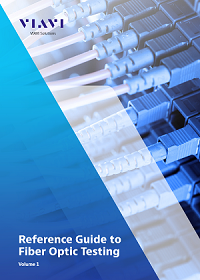
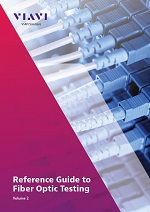
Besides the
FOA reference materials, two JDSU/VIAVI textbooks, Reference
Guide to Fiber Optic Testing, Volumes 1 and 2, were used
as references for some of the FOA courses and are recommended
for instructors and students. The books are available from VIAVI
as eBooks and the everyone should download them and recommend
them to others.Download yours now. Volume
1. Volume
2. Viavi Books
50th
Anniversary of The Development of Low Loss Fibers A
history of the development of low loss fiber, a fascinating
story by Jeff Hecht on the OSA (Optical Society of America)
website.
How
OFS Makes Fiber
Interesting YouTube video on how fiber is made. Perhaps a little
too much "show biz" but fascinating. If you have ever seen fiber
manufacture, look at this video. You will be amazed at how big
preforms have become!
How
Nexans Makes Copper Cables - compare the process to
fiber - don't most of the machines look similar?
The
True Cost of Telco Damages (what backhoe fade or
target practice can cost)
Rural
Electric Cooperatives: Pole Attachment Policies and Issues,
June 2019.
Ckearfield-FOA
Certification Training Clearfield is now
offering their customers an FOA
CERTIFICATION course. This course provides a
basic understanding of fiber optic technology, as well as
Clearfield product knowledge and how Clearfield’s integrated
product systems work together in a fiber network.
Substandard
Contractors - Fiber Optic Knowledge Doesn't Always Trickle
Down (EC Mag)
Another
Source Of Articles On Fiber
FOA
President and editor of this newsletter Jim Hayes has also been
writing a column in Electrical
Contractor Magazine for almost 20 years now. Electrical
contractors do lots of fiber work and this column has covered
some topics they are interested in including installation
processes, network design, fiber applications and a lengthy
series on dark fiber - what it is, how's its used and how it
benefits the growth of communication. A recent web site redesign
makes it easier to browse all these articles - just go to http://www.ecmag.com/contributing-authors/jim-hayes
and you can see all of them.
Upgrade
Your KSAs
You should
consider upgrading your KSAs - your knowledge, skills and
abilities related to your work in fiber optics and keep up to
date with new applications. It should help your business "bottom
line" - income and profit, that is.
FOA has just the place to learn - Fiber
U. Fiber U offers 15 free online courses
starting with an introduction to fiber optics for those new to
fiber and including courses covering installer skills topics
(basic fiber, basic skills, OSP construction and installation,
testing and OTDRs), a course for those designing fiber optic
networks, and six courses on specific applications of fiber
optics (FTTx, OLANs, fiber for wireless, cell tower antennas and
DAS, and data centers.)
If you are a working fiber tech, the applications courses can
enhance your ability to get business in those areas because you
will know the specifics of the applications. With so much work
being done on wireless (small cells, 4G/5G) and data centers
(small to hyperscale), understanding these applications can
certainly improve your prospects in those markets.
Learning more from the skills courses like testing and OTDRs is
a no-brainer, but you might look at our upgraded "Basic
Fiber Optic Skills Lab" too. You might find it will help
you upgrade your skills, but we have another aim for the basic
skills self-study.
If you are a contractor who has new employees that you want to
upgrade their skills or apprentices who are just starting in
fiber optics, the Basic
Fiber Optic Skills Lab lets them use their own tools
and components to learn installation skills they
use daily on the jobs. The new workbook we've added to the
basic skills lab guides the person taking the course
through the exercises and provides worksheets to record
the results of their labs. We've upgraded the virtual
hands-on (VHO) tutorials also and made them so you can
download and print them to help you with the steps in the
exercises.
Can
You Learn Hands-On Skills Online?

Knowledge is easy to learn online, but learning skills requires
"hands-on" practice and that requires tools and components to
practice with. Here at FOA, we've been working on an online
course that could help many techs learn new skills or improve
others using an online self-study course and their own
equipment. Recently,
we have updated the materials in the Fiber
Optics Basic
Skills Labs which includes cable preparation,
splicing, termination and testing. And we have created a Basic
Skills Labs - Copper Premises Cabling to cover UTP
(Cat 5) and coax copper cable processes. As with all Fiber
U courses, these are free.
The course on Fiber
U called "Basic
Fiber Optic Skills Lab" introduces you to the tools
and equipment then takes you through cable prep, splicing,
termination and testing. Recently we have been working on
improving the course to make it easier and more effective.
We've added a Basic Skills Workbook for each topic in
the course that you can download to guide you through the study
and hands-on exercises. We've updated what we call "Virtual
Hands-On" (VHO) tutorials where we use an analysis of the
activities to break them into step-by-step instructions that
help you learn the processes. We've also added new technologies
like splice-on connectors (SOCs) that have become very popular.
Similarly, we
have created a Basic
Skills Labs - Copper Premises Cabling to cover UTP
(Cat 5) and coax copper cable processes. It has a lab
workbook, VHOs on each topic and quizzes to allow you to
check your knowledge. If you have to tools, you can do
all the processes on your own.
If you are a newcomer to fiber optics, have completed the Basic
Fiber course and already have a set of fiber
tools, this course will help you to learn how to
use the tools and learn basic fiber installation practices
which you can practice using your own equipment. If you are a
CFOT or working tech now and want to learn some new processes,
this can help you too.
Like all Fiber U courses, the Fiber
U Basic Fiber Optic Skills Lab is free.
10GPON
Update In FOA Guide
FOA has
updated its page on FTTH PON protocols to include the latest
standards for 10GPONs. There are three standards, NG-PON2,
XG-PON and XGS-PON. As is common with all communications
networks, work on upgradeing network capability and speed starts
as soon as a network is introduced and PONs are no exception.
GPON has been the most widely used PON scheme for both FTTx
netowrks and passive optical LANs (OLANs) and GPON has been
upgraded to several versions with higher transmission speeds and
higher power budgets to allow greater distance, higher split
capability, or both. The assumption is that a fiber network has
a lifetime of up to 40 years, so upgrades to GPON have assumed
that they will use the same passive optical network architecture
and fiber type (G.652 singlemode.)
Furthermore, upgrades have been designed around coexistence with
current GPON networks. By utilizing different wavelengths, it is
possible to have these newer, faster networks sharing the same
passive optical network as the original GPON system, allowing
offering higher speeds to users while continuing to serve
current users without disruption. Some commercial users can take
advantage of higher speeds while typical consumers are well
served by GPON. One of the big advantages of the PON upgrade
standards is the ability to overlay networks. Thus a city could
operate one regular GPON network for consumer FTTH use and have
another, faster network operating on the same cable plant
independently, offering a higher level of service and security.
More on
PON Protocols in the FOA Guide.
Introducing
Lennie Lightwave's Guide - 25th Anniversary Edition
FOA has
reprinted "Lennie
Lightwave's Guide" on its 25th anniversary in a special
print edition.
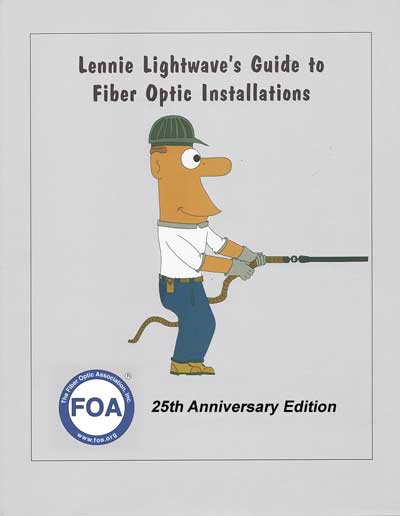
Many of you have used the current online version of Lennie's
Guide on the FOA website. Now you can have a slick printed
version - real paper - you can hold in your hand and read. Leave
a copy on your desktop to impress your friends, or on the table
in your company's reception area instead of out-of-date
magazines. Give them to your customers and employees to help
them learn fiber optics. Use it to prepare for FOA
certifications. FOA will be giving them away at conferences like
the IMSA Annual Conference in New Orleans later this summer.
You can get your own copies of Lennie
Lightwave's Guide at Amazon.com, only $9.95US.
Another
Look At Connector Contamination
Brian
Teague of Senko
Advanced Components sent us the results of an interesting
experiment he ran to show an unusual effect of the contamination
on a connector. He started with a clean SC/UPC singlemode
jumper, shown in the 400X image to the left. Then he connected
it to a 1310nm laser test source and measured the power out of
the fiber with a fiber optic power meter. Then he disconnected
the connector from the meter, touched the end to his finger,
contaminating the end of the ferrule as you can see in the image
on the right.
But then he connected the dirty connector to the meter and
measured the power again. The power was decreased by 0.22dB.
Yes, the contamination on the connector acted as an attenuator
to reduce the power considerably. Think what would happen if you
them mated it to another connector. Not only would you see the
attenuation caused by the contamination, you will probably see
even more loss caused by the gap created by the flakes of skin.
That's why you should inspect, clean and inspect again to ensure
all connectors are clean before testing or making connections.
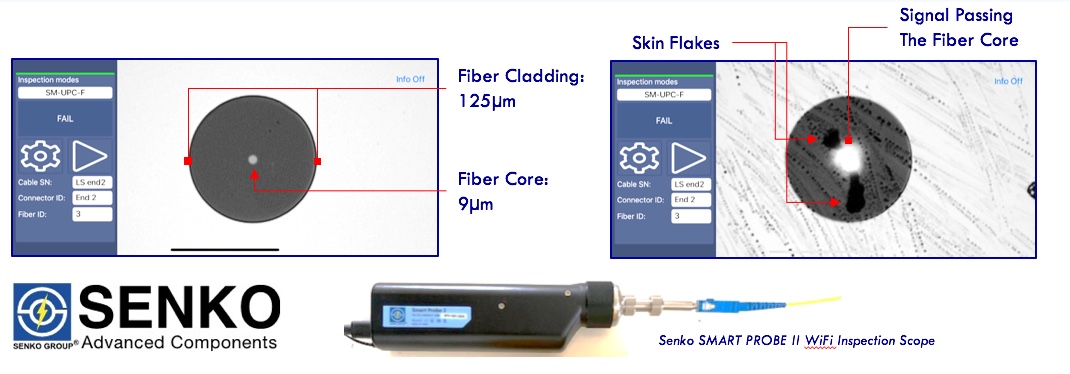

Updates
We are
continually updating the Online Reference Guide to keep up with
changes in the industry and adding lots of new pages of
technical information. When you go to the FOA
Guide Table of Contents to see the latest updates - look
for  . .
PON
Protocols in the FOA Guide. 10GPON
Update In FOA Guide
Basic
Fiber Optic Jargon, OSP
Fiber
Optic Jargon and Fiber
Optic Jargon for managers.
FOA
has a new page on Restoration
The
updated Fiber
Characterization page in the FOA Guide goes in to more
depth on why fiber characterization is important, what tests
need performing and how to interpret results.
Practically every page in the section of the FOA Guide on Fiber
Optic Testing has been reviewed and updated, much of it based on
the new FOA textbook on testing. This includes pages on
measuring power, fiber attenuation, connector or splice loss and
cable plant loss. Browse
through the testing section and see what's new.
We've
started with a page in the FOA Guide on Fiber
Optic Network Management that describes what our advisors
think is important and created a page to introduce them to the
language and technology of fiber optics which we call "Fiber
Optic Jargon - Illustrated." Over time, we'll be expanding
this section and create a Fiber U self-study course also.
FOA has
created a new section of the FOA
Guide on OSP
Construction.
Inspecting
and Cleaning Connectors.
Dirty
connectors are one of the major problems in fiber optics,
causing high connector loss, high reflectance and contaminating
transceivers. Network operators claim that 15-50% of all network
problems can be traced to dirty connectors causing connection
problems.
FOA
Guide section on inspecting and cleaning connectors.
Go
to The
FOA Online Fiber Optic Reference Guide.
FOA
School Offers Toolkit With Online Training
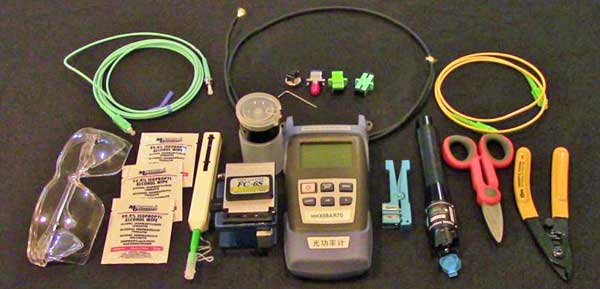
Slayton
Solutions (FOA Approved School #156) is offering a simple
fiber optic tool kit that includes a 29-piece set of fiber
optic tools and a power meter along with training videos and
online instruction for only $499. 29 Piece Kit includes all
tools and devices a technician needs to install fiber optic
connectors and test optical power. Information
on the kit is available on YouTube.
You can contact them for more information at
slaytonsolutions@sbcglobal.net
or https://www.fiberopticsinstitute.com
New
FiberNext Job Board And Savings Club For CFOTs

FOA
Approved School FiberNext
has created an online job board for fiber techs and a special
"savings club" for CFOTs.
Job
Board
The
Job Board was designed to help connect employers with fiber
technicians and other fiber optic professionals. It is a place
where employers in the fiber optic market can post job
openings and a place where fiber optic professionals can post
that they are looking for employment. Please feel free to post
an opening or browse for your next job or employee. https://fibernext.com/job_board.php
Savings Club
FiberNext, besides being an FOA approved school is also a
distributor. FiberNext invites FOA CFOT®s to join the “FiberNext
CFOT® Club to get special savings on selected fiber optic
products. Visit https://fibernext.com/cfot_club.php to
sign up today ”
Recycling
Fiber Optic Cable
We
received this note from Steve Maginnis, LD4Recycle/ CommuniCom
Recycling on recycling fiber optic cable:
We have 3 Processors gearing up to accept fiber optic
cable (FOC). As we all know, all FOC is not the same. Several
truckloads of “typical” FOC scrap from FOC mfgrs and “typical”
FOC and Coax cable have been studied and tested.
Therefore, today you can begin contacting me with the type FOC
material or scrap you toss to the landfills today. We need to
quantify the expected feedstock. Our expectation for quantities
is quite large (tons) but there is a capacity limit. And I do
have several processors that can take ALL materials and others
that can accept LIMITED types of FOC material and quantity.
Contact:
Steve Maginnis
LD4Recycle/ CommuniCom Recycling
(Visit our new
website)
sm@LD4Recycle.com
803.371.5436
Safety
On The Job
Safety is
the most important part of any job. Installers need to
understand the safety issues to be safe. An excellent guide to
analyzing job hazards is from OSHA, the US Occupational Safety
and Health Administration. Here
is a link to their guide for job hazard analysis.
FOA also has lots of information on safety: FOA
Guide, YouTube
video and a Safety
Poster
Best
Practices Guide For Underground Construction
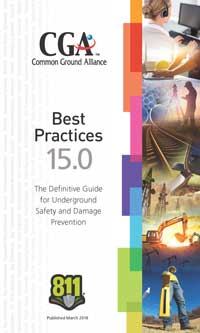
We assume
you are familiar with the "One Call" and "Call Before
You Dig" (811) program, but are you also familiar "Click
Before You Dig.com" and with the people behind it -
the Common Ground Alliance and their Best Practices website?
CGA
is a member-driven association of 1,700 individuals,
organizations and sponsors in every facet of the underground
utility industry. Established in 2000, CGA is committed to
saving lives and preventing damage to underground
infrastructure by promoting effective damage prevention
practices. CGA has established itself as the leading
organization in an effort to reduce damages to underground
facilities in North America through shared responsibility
among all stakeholders.
Officially
formed in 2000, the CGA represents a continuation of the
damage prevention efforts embodied by the Common
Ground Study.
Sponsored by the U.S. Department of Transportation and
completed in 1999, this Study represents the collaborative
work of 160 industry professionals who identified best
practices relating to damage prevention. Any
best practice or program endorsed by the CGA comes with
consensus support from experts representing the following
stakeholder groups: Excavators, Locators, Road Builders,
Electric, Telecommunications, Oil, Gas Distribution, Gas
Transmission, Railroad, One Call, Public Works, Equipment
Manufacturing, State Regulators, Insurance, Emergency
Services and Engineering/Design.
Read
the CGA Best Practices Guide here.
Here
are all the CGA resources for damage prevention.

The word on
the "Dig Once" program is getting out - FOA is getting calls
from cities asking us for information and advice. It helps that
the current Administration is trying to convince cities of the
advantages of installing ducts or conduits when they dig up a
street so they don't have to do it again. Here are some links
for more information.
The DoT page on the administration’s Executive Order: http://www.fhwa.dot.gov/policy/otps/exeorder.cfm
From the Council of State governments: http://www.csg.org/pubs/capitolideas/enews/cs41_1.aspx
From the city of San Francisco: http://sfgov.org/dt/dig-once
An article about Dakota County, MN: https://muninetworks.org/tags/tags/dig-once
And
the one to download and hand out:
A “How To” Guide from The Global Connect Initiative: https://share.america.gov/wp-content/uploads/2016/04/6.-GCI-Dig-Once.pdf
Useful
Online Resources
We often
have contacts give us online links for useful information which
we like to share with our readers. Here are two:
Why
We Warn You To Be Careful About Fiber Shards
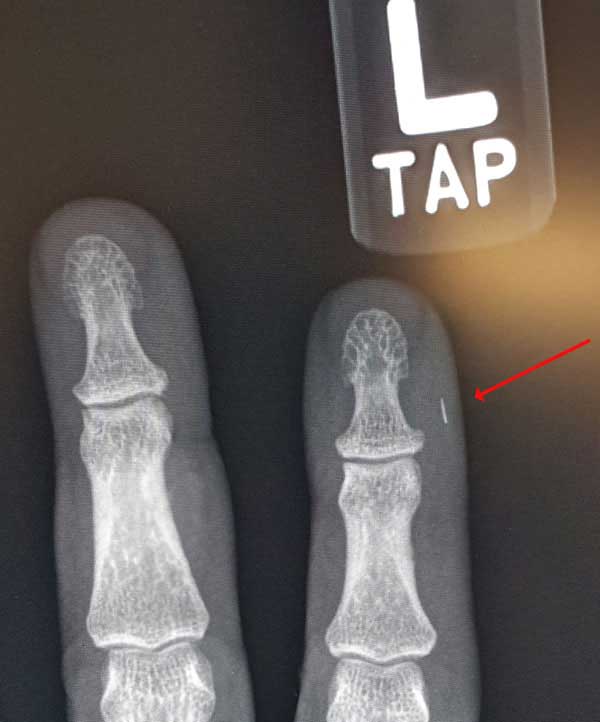
Photo courtesy Brian Brandstetter, Mississauga
Training Consultan
FOA
Facts
FOA is a
non-profit professional association chartered to promote
professionalism in fiber optics through education, certification
and standards. FOA is mostly known for certifying techs -
mostly CFOT®s
-Certified Fiber Optic Technicians - but also may be CPCTs -
Certified Premises Cabling Technicians or corporate
members involved in fiber optics.
FOA is a "virtual organization" - we have no "brick and mortar"
presence. We operate over the Internet with operations centered
in California, with active workers and volunteers in locations
as diverse as Texas, Ohio, Canada, Singapore, Malaysia, Denmark,
South Africa, the Middle East and many more.
Being a virtual organization, FOA has very low overhead,
allowing us to offer cost-effective certifications and many free
programs to support our industry.
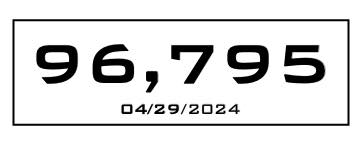
As of today, FOA has certified this many techs. About 90% come
from our schools but many experienced techs have become FOA
CFOT-certified directly through our "Work-to-Cert"
program.
FOA has almost 200 approved training organizations in about 40
countries around the world around the world.
FOA
Certifications Now Last For 3-Years
Beginning
in 2019, all FOA certifications issued or renewed will be for a
period of 3 years. Most certification bodies worldwide have
standardized on 3 year certifications. FOA has been working with
a number of organizations that use our programs but have
standardized on 3 year certifications. FOA has decided that it
is time to change our policies to align with the majority of
other organizations.
Remember that FOA certification renewals include all the
certifications one individual has for one price. FOA does not
charge for any additional certifications, so, for example, if a
CFOT also has specialist certifications like the CFOS/T or
CFOS/S, they are included at no additional cost when the basic
certification is renewed.
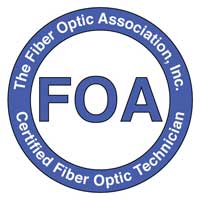
FOA has 14
fiber optic certification programs covering every aspect
of fiber optic network design, installation and operation.
Primary
Certifications: CFOT (basic fiber), CPCT (premises cabling),
CFOS/O (outside plant, taught with CFOT included) and CFOS/D
(fiber optic network design).
Skills Certifications (for installers and techs, requires
CFOT): CFOS/S (splicing), CFOS/C (connectors/termination),
CFOS/T (testing), CFOS/FC (fiber characterization).
Applications Certifications (for techs or anyone, including
managers and supervisors): FTTH (fiber to the home), CFOS/L
(optical LANs), CFOS/DC (data centers), CFOS/A (fiber to the
antenna), CFOS/DAS (distributed antenna systems) and CFOS/W
(fiber for wireless)
 (what you are reading)
(what you are reading)
FOA monitors the trade press, websites and other
resources continually to look at what's happening in many
technologies that affect fiber optics. We're tracing
technologies as diverse as wireless, IoT, autonomous vehicles,
smart cities, energy, or anywhere fiber is used to bring news to
our readers.
FOA continually updates our technical materials, online and
printed, and our curriculum to ensure our readers have access to
the latest technical information and our schools teach the
latest technology and applications. Our printed books are being
updated right now.

FOA created the
FOA Online Guide as a non-commercial trustworthy technical
reference almost a decade ago so the industry would have a
reliable technical reference. In the last year, over 1million
visitors downloaded about 4 million pages of technical
information.
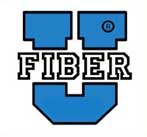
FOA offers free online self-study programs at Fiber
U. In 2017, the number of online sessions doubled to
200,000. Many of those are preparing for FOA certification
programs - taking courses at our schools or using the "Work-to-Cert"
program. Some of our schools are requiring Fiber U programs as
prerequisites for their classroom courses so they can spend more
time on hands-on activities.

FOA offers over 100 educational YouTube
videos that have been viewed 2.4 million times.
FOA offers its training programs to other organizations at no
cost to help them train their members properly in fiber optics.
For example, FOA has been working with the Electrical Training
Alliance (IBEW/NECA) for over 20 years, training their
instructors for their apprenticeship programs. We work with many
other organizations and companies to provide the materials they
need.
FOA has about 300 corporate
members - companies in various aspects of the fiber optic
industry worldwide that we list online and offer discounts on
certifications and renewals.
FOA provides speakers for many conferences and even
presentations for use by other organizations to educate people
on the aspects of fiber optic communications.
FOA has a program to provide classroom
materials for STEM
teachers (science, technology, engineering and math)
introducing K-12 students to fiber optics and creating science
projects.
FOA provides forums for discussion on various social media. Our
LinkedIn groups have about 5,000 members each. If you are not
joining us on social media yet, please do.





Interested
In A Career In Fiber Optics?
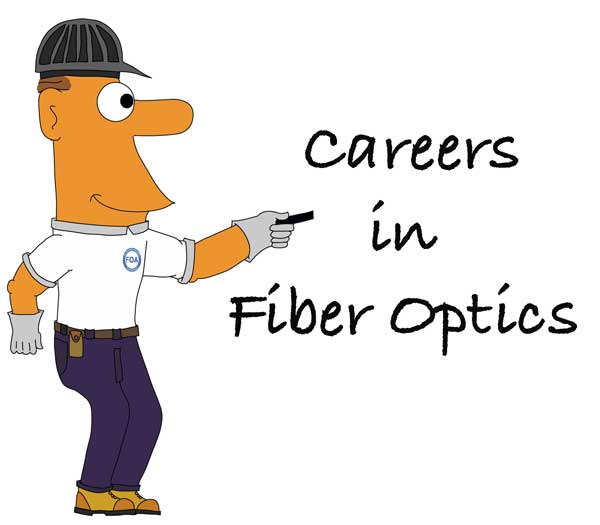
FOA has created a new YouTube video to introduce students to
careers in fiber optics. It was made for showing to high school
and junior high students interested in tech careers but anyone
interested in a possible career in this field will find it
interesting. If you have kids in school or know teachers, let
them know about this too. Watch the FOA
Careers In Fiber Optics Video on YouTube and visit the FOA
Careers In Fiber Optics web page at www.foa.org/careers/.
ts
1-844-440-0047
www.fiberoptictraining.com
Fiber
Optic Education For Students At Any Age
We hear
about fiber optics all the time - it's in the news whenever we
hear articles about high tech, the Internet and communications,
and many communities are getting "fiber to the home." But few
people really understand fiber optics or how it works. FOA is
focused on educating the workforce that installs and operates
these fiber optic networks but we're always getting inquiries
from STEM (science, technology, engineering and math) teachers
who want to introduce fiber optics to younger students in K-12
grades or technical schools.
We
start with the FOA
Careers In Fiber Optics Video on YouTube and visit the FOA
Careers In Fiber Optics web page at www.foa.org/careers/.
These are for students who think they might be interested in
careers in fiber optics and want to know more about what fiber
techs do.
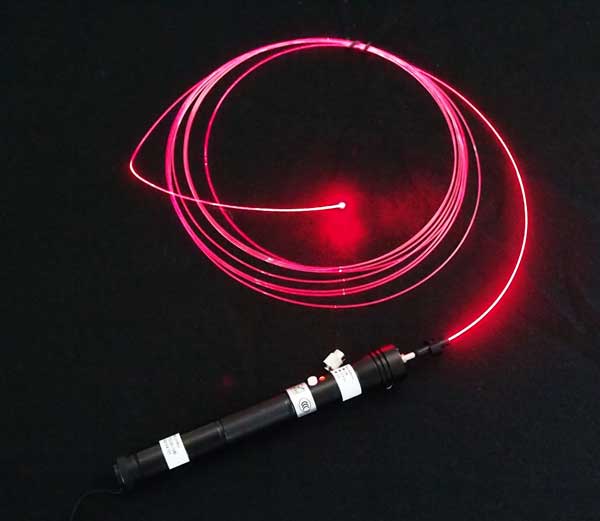
Using red laser light (a VFL here but a laser pointer works
also) to show how fiber guides light.
FOA has begun developing a series of YouTube videos intended for
teaching students in elementary, middle and high schools about
fiber optics. The first FOA video is titled "Fiber
Optics For Teachers." With this video, we show teachers
how fiber works and carries signals and then explains simple
experiments to demonstrate how fiber optics works in the
classroom using some plastic fiber and a laser pointer. Since
many teachers do not know where to get the fiber, the FOA offers
to send them a sample for use in demonstrations in their
classroom (USA only right now.)
At the end of the video, teachers are given directions on how to
request samples of the plastic fiber from the FOA.
This video joins the "Fiber Optics Live" series How
Light Travels In A Fiber, Fiber
Attenuation and Connector
Loss that show how fiber works using simple experiments
that can be duplicated in any classroom. More videos will be
coming soon.
If you have kids or know some teachers who would be interested,
please send them to the introductory video Fiber
Optics For Teachers and we'll be glad to help them
get started with some entertaining programs for their
classrooms.
Resources
For Teachers In K-12 And Technical Schools
Teachers in all grades can introduce their students to fiber
optic technology with some simple demonstrations. FOA has
created a page for STEM or STEAM (science, technology,
engineering, arts
and math) teachers with materials appropriate to their
classes. Fiber Optic
Resources For Teachers.
If
you have kids in school or know teachers who are interested,
send them to the FOA page Fiber
Optic Resources For Teachers.
Should
Your Company Become An FOA Corporate Member?
As all FOA
individual
members know, they join the FOA by becoming certified,
mostly taking their CFOTs but some CPCTs, either by
attending a FOA approved school or joining directly based on
field experience (our "work to cert" program.) Over the years,
we've been contacted by manufacturers, contractors, consultants,
and other types of organizations who ask about becoming members.
We don't certify companies or organizations, we told them, so we
were not sure what we could offer as a benefit of membership.
But then, companies asked about using our educational programs
to train employees, how they could get listed on the FOA website
as service providers or if they could get a quantity discount on
membership or certification for all the FOA members working for
them. That began to sound like a benefit for being an FOA
corporate member. And providing a list of useful suppliers to
the market could be a benefit to the industry as a whole.
So FOA has quietly been letting companies and other
organizations join the FOA to take advantage of those benefits
so we now have several hundred corporate members. We've put then
into a database and listed them on the FOA website in map
and list
form. Here's the map.
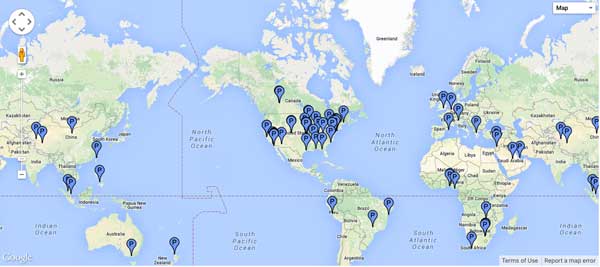
The online map
and list
can be used to find suppliers and service providers.
The map, like our map of schools, lets you find the FOA
corporate members close to you. The table form lists them
by category: Installer/Contractor, Component Manufacturer,
Installation Equip. Manufacturer, Transmission Equipment,
Services/Consulting, Distribution and Users of Fiber Optic
Networks. You can sort the tables to find members meeting your
needs, e.g. by location, certifications offered, etc. Click on
any column heading to sort that column; click twice to sort in
reverse order.
How
Does An Organization Become An FOA Corporate Member?
Simple,
just fill in the online
application form. When your application is accepted, you
will be asked to pay the one time membership fee - $100US. You
will then be listed on the online
map
and list,
have access to exclusive FOA educational materials for your
employees and get discounts on certifications and
renewals.
Events of
Interest: FOA
now posts events on our LinkedIn groups, Facebook page and
other social media

FOA
has a company page and three LinkedIn Groups
FOA
- official company page on LinkedIn
FOA
- covers FOA, technology and jobs in the fiber optic marketplace
FOA
Fiber Optic Training - open to all, covers fiber optic
technology and training topics
Grupo
de La Asociación de Fibra Óptica FOA (Español)
RETURN
TO INDEX
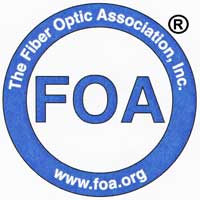 FOA Resources
FOA Resources
FOA
Standards:
FOA offers free standards for datalinks and testing the
installed fiber optic cable plant, patchcords and cable, optical
power from transmitters or at receivers and OTDR testing. Look
for the "1
PageStandard" web page and in the FOA Online Reference
Guide.
NECA/FOA
301 Fiber Optic Installation Standard
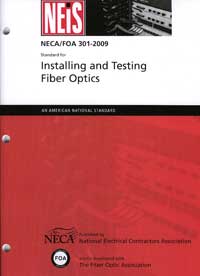
Standards
cover components and systems and how to test them, but rarely
get into installation issues. The FOA NECA 301 standard which
covers installation of optical fiber systems has been revised
for the second time, adding considerable new materials. This
standard is derived from FOA educational material put in
standards form and approved by ANSI as an American National
Standard. It's specifically written to be used in contracts to
define "installation in a neat and workmanlike manner." The
standard is available from NECA.
FOA members can go
here for instructions on how to download your free copy.
RETURN
TO INDEX
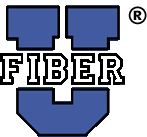
Free
Fiber U Self-Study Programs
FOA's
"Fiber U" free online self-study programs help you learn about
fiber optics, study for FOA certifications or use them to help
create "blended learning" classes. There are two new free online
self-study programs on Fiber
U. Fiber Optic Network Design is for those interested in
learning more about how to design fiber optic networks or
studying for the CFOS/D certification. FTTx is for those wanting
to know more about fiber to the "x" - curb, home, wireless, etc.
- or studying for the CFOS/H certification.
Got to Fiber U
for more information.
Fiber U
Online Self-Study Programs Offer Certificates of Completion
FOA has
been offering quite a few free online self-study programs on Fiber
U, our online learning site. We are always getting
questions about getting a certificate for completing the course
online, so we have setup an option to take a test online and get
a certificate of completion for these online courses.
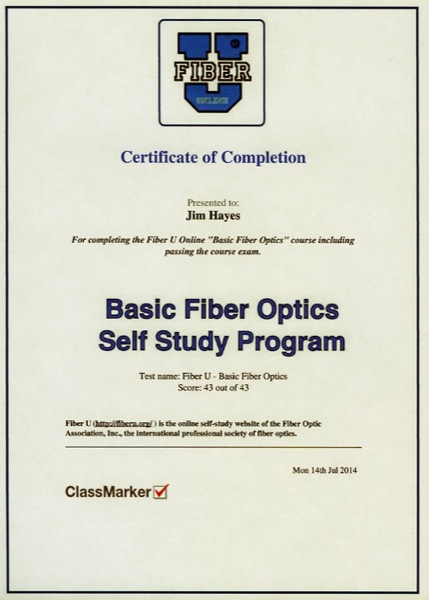
While it's not FOA certification, FOA will recognize a Fiber
U Certificate of Completion as background experience to
qualify for applying for FOA certifications. We also intend to
expand the program to more specialized topics as preparation
for FOA specialist certifications.
If you have associates that want to get started in fiber,
have them take this course online to get started. Go to Fiber
U and get started.
FOA
Books And Publications
Updated
Books
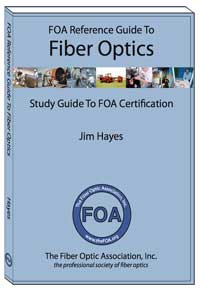

Many textbooks are behind the technology because they are
rarely updated. FOA really keeps our textbooks up to date. We
did a major update a year ago and another was just completed.
The The FOA
Reference Guide To Fiber Optics has been updated
to reflect new components like OM5 fiber, testing for fiber
characterization and more information on installation.
The FOA
Reference Guide To Outside Plant FIber Optics
has been expanded to include an extensive section on outside
plant construction taken from Joe Botha's
OSP Construction Guide textbook. This additional
material is being added to support the new FOA CFOS/O OSP
tech certification program which now includes of OSP
construction.
FOA
Basic Fiber Optic Textbook Available in French and Spanish

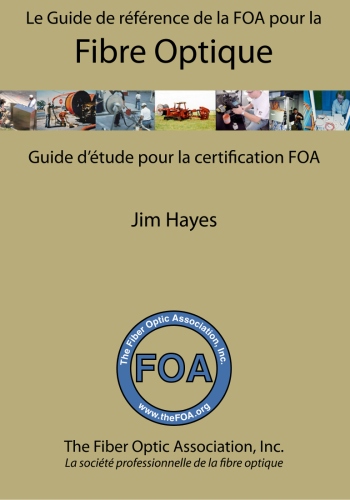
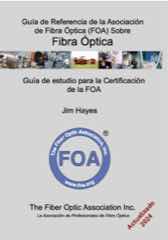
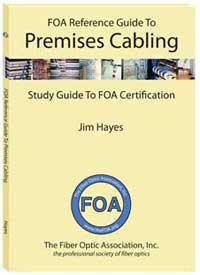

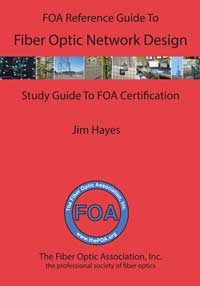
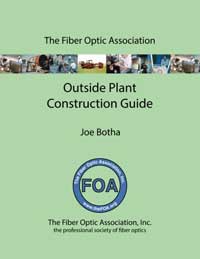
Libro
de Diseño para Redes de Fibra Óptica en
Español - FOA
Design Book Available In Spanish Online
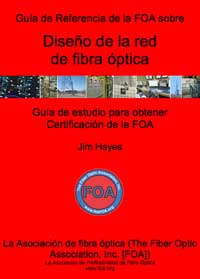
FOA has translated the FOA Guide To Fiber
Optic Network Design book and made it available online to
those studying for the CFOS/D Certification but whose native
language is Spanish. You
can access the Spanish translation of the Design book here.
A printed version will be available in the near future.
Lennie
& Uncle Ted Guides - Perfect For Getting Started
Lennie
and Uncle
Ted's Guides have moved to the FOA website.
Lennie is the place where many if not most fiber techs
begin their education. FOA has just updated the two
guides to ensure they stay relevant - more than 20 years
after they were first written.
Lennie goes all the way back to 1993 when he was created
as the mascot of the original "Fiber U" conference - the
same Fiber U that is now the FOA's web-based training
site. Lennie
Lightwave's Guide To Fiber Optics was created
as a beginner's introduction to fiber optics. Over
60,000 printed version of Lennie's Guide were given away
and it became one of the first commercial web pages in
1994. Uncle Ted's
Guide To Communications Cabling was written a
few years later to introduce techs to "Cat 5" - UTP
wiring - that had only recently been standardized in
TIA-568.
Lennie and Ted's Guides are used in the current Fiber U
online self-study programs and are still the best place
to start learning about fiber optics.
Lennie
and Uncle
Ted's Guides are online at the links here, can be
downloaded as printable PDFs and are now also available
as free iBooks on iTunes.
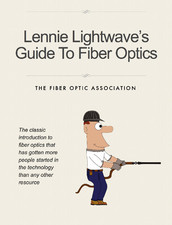
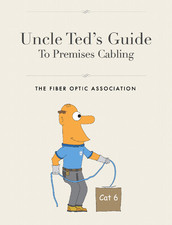
Lennie
Lightwave's Guide to Fiber Optics and
Uncle
Ted's Guide To Communications Cabling
are now available free to iPad users who can download them from
the Apple iTunes store. Of course they are still available
online or for download.
You can also find these free guides on the FOA website - go here
for all the links: Lennie
Lightwave's Guide to Fiber Optics and Uncle
Ted's Guide To Communications Cabling
Download PDFs of Lennie
or Uncle Ted.
RETURN
TO INDEX
FOA
iPad Apps
FOA
LossCalc
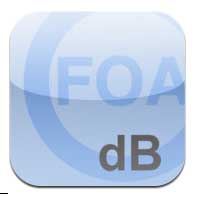 FOA
LossCalc estimates the optical loss of a fiber optic link. This
will save time for the installer of a fiber optic link needing
to know whether test results are reasonable and/or make a
"pass/fail" determination. It can also help the designer of a
link to determine if communications equipment will operate over
this link. FOA
LossCalc estimates the optical loss of a fiber optic link. This
will save time for the installer of a fiber optic link needing
to know whether test results are reasonable and/or make a
"pass/fail" determination. It can also help the designer of a
link to determine if communications equipment will operate over
this link.
By choosing the type of link (singlemode or multimode) and
specifying the length of the fiber and numbers of connections
and splices, it will calculate the end to end loss of the link.
The app has default specifications for singlemode and multimode
links or the user may create custom setups with specifications
appropriate for any application. http://itunes.apple.com/us/app/foa-losscalc/id476262894?mt=8&ls=1
RETURN
TO INDEX

The
FOA has many videos on  ,
including two Lecture Series (Fiber Optics and Premises
Cabling), Hands-On lectures on both and some other informational
and instructional videos. For all the videos, go
to the FOA Channel "thefoainc" or use the direct links
below. ,
including two Lecture Series (Fiber Optics and Premises
Cabling), Hands-On lectures on both and some other informational
and instructional videos. For all the videos, go
to the FOA Channel "thefoainc" or use the direct links
below.
View
a complete list of FOA Videos with links to each video on
YouTube.
Where Are
The Jobs In Fiber Optics? FOA talks about all the
applications for fiber optics, what jobs involve and the
qualifications for the workers in the field.
Fiber
Optics - Live! A
series of videos that use lab demonstrations to show how
optical fiber works.
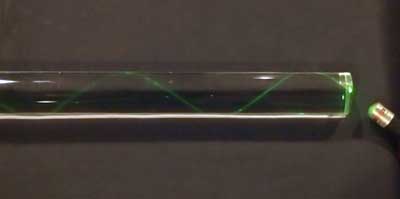
Cabling
Project Management - what's involved in a
copper/fiber/wireless project -advice for the customer and the
contractor
Hazards
Of Counterfeit Cable
You may
have read the stories we have written about the counterfeit
"Cat 5" cable made from copper-clad aluminum rather than pure
copper. Recently we tried an unscientific burn test on the
cable compared to a known good UL tested cable and posted a
video on YouTube. You can see the results below.
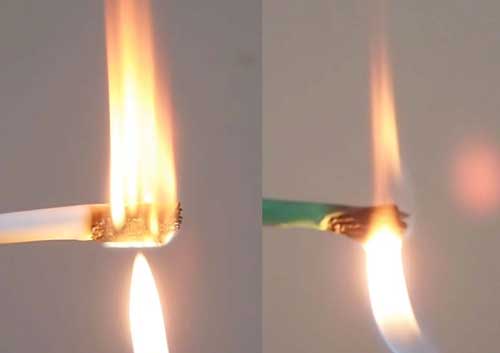
Counterfeit
Cable Real UL-rated cable
The
difference is obvious and the danger is real. Watch the video
on YouTube: Premises
Cabling Lecture 11: Counterfeit Cat 5 Cabling
View a
complete list of FOA Videos with links to each video on
YouTube.
View
all the FOA Channel on YouTube.
RETURN
TO INDEX
FOA
Schools
New
School:
Midwest
Communications Technologies, FOA
Approved School #378.
Find
a listing of all the FOA-Approved schools here.
Find An FOA-Approved Training
Organization
Most
inquiries we get regarding finding a FOA-Approved training
organization want to know two things: what school is closest to
me or what school offers the certifications I need. The FOA has
about 200 training organizations we have approved worldwide so
finding the right one can be difficult! We've been looking at
ways to make it easier, and we think we've got a good solution.
In fact we have two solutions.
First we have added a sortable
table of all the FOA-Approved schools.
You can also use our FOA
Google Map to find FOA-Approved schools.

What
Should A Fiber Optics or Cabling Tech Know and What Skills Do
They Need?
FOA
certifications are based on our KSAs - the Knowledge, Skills and
Abilities that techs need to succeed. Read the FOA KSAs
for fiber and cabling techs.
School News
Feedback
We always
enjoy feedback, especially when it shows how great some FOA
instructors are. These came from students of Tom Rauch, an
instructor at BDI
Datalynk:
"I took your fiber optics certification courses this past March.
I just wanted to let you know that in two weeks I start working
as a fiber optic technician with ___ up in ___. You mentioned on
the first day of the course that there is always one guy in
class who had rubbed his last two nickels together to be there
and, in that instance, I was that guy. Now I'm going to be able
to provide for my family like never before and I owe it to the
certification that I received from you and BDI Datalynk. I just
wanted to thank you again."
"Thanks to our tremendously knowledgeable and patient instructor
Thomas Rauch, who was not only generous in sharing his wealth of
information, but he did so with ease, humor and in a way that
invited curiosity and participation. He was encouraging and
proud of our accomplishments and helped us learn from our
mistakes in a way that did not break our confidence, rather it
pushed us to better results the next go around. The hands on
labs were just AWESOME!" Just thought you should know what a
class act you have representing you in his travels..... but then
again you probably already knew that! : )
In almost 19 years at Verizon and having held numerous
positions, I have gone through many training sessions. I cannot
remember ever having been actually looking forward to coming
back to class quickly after lunch, to get back to the hands on
activities, and walking away with the sense of empowerment that
the information presented was not only relevant but dead on
point accurate! I will be signing up for the Outside Plant class
on March! I can't say enough good things about Tom and his
impact! Feel free to quote me, I can only imagine that he will
open so many doors and change so many lives in the years to
come, with his style of teaching! Great experience, awesome job!"
IBEW
and FOA Partner on Fiber Optic Training
The
International Brotherhood of Electrical Workers (IBEW) and the
National Electrical Contractors Association(NECA) through the
National Joint Apprenticeship and Training Committee
(NJATC) in
a partnership with the FOA has published a new textbook for
training IBEW apprentices and journeymen in fiber optics. The
new textbook uses the material from the FOA Reference Guide To
Fiber Optics with new material and photos from other NJATC
training partners.
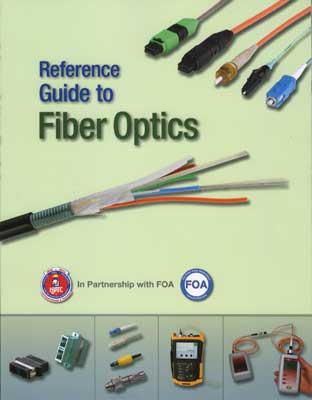
Quote
from one of our certified instructors: I want to thank
you and your organization for all the resources you provide for
the students and the opportunity to offer the certification to
the students. The fact that you published the book yourself to
get the cost down and the unlimited free resources on your
website shows a commitment to the public that is second to none.
I let it be known to the students that the FOA is the best in
the industry at supplying knowledge and resources related to the
communication industry. I look forward to passing on the
information that you provide for the industry.
RETURN
TO INDEX
Good
Question! Tech Questions/Comments Worth Repeating
New:
The FOA Fiber FAQs
Page (FAQ s = frequently asked questions) gathers up
questions readers have asked us and adds tech topics of
general interest.
Questions
From FOA Newsletter Readers
April 2020
Restoration
Time
Q: Do you have any statistical data on how long (on
average) it takes for a utility network operator to detect and
pinpoint the exact location of a fiber cut?
A: We don’t have any information on the average time it
would take to find a fiber fault and like all averages, it might
not have a lot of meaning.
Many fiber optic links today have alarms that indicate loss of
transmission so they tell you immediately when the link goes
down. Identify the link and the fiber connection. Then it
becomes a matter of troubleshooting and eliminating causes.
Sometimes even when reconnected the equipment requires a system
reset to get started.
First - check the power on the equipment
Secondly: determine if someone was doing something in the
equipment area that might have caused a problem. We do know of a
link that was brought down because an executive giving a tour
disconnected a live link to show someone a fiber connector! If
someone was working nearby, check that area first - patchcords,
cables, etc. Don’t forget to check work records to see if a crew
is working around the cable plant at that time. It’s possible a
crew installing new cables damaged old ones. See the FOA
newsletter for this month for what installers do on aerial cable
plant https://www.foa.org/foanl-3-20.html or last month for
underground https://www.foa.org/foanl-2-20.html.
If it appears to be in the cable plant and nobody is working
near it, OTDRs are generally used for troubleshooting. They get
you into the area where the problem is and them it’s finding it
manually. Underground it’s often contractors digging or boring,
overhead it’s just poor workmanship - or as a guy from
Bonneville Power put it, it may be “target practice” although
animals damage aerial cables too.
FOA has a page on restoration
https://foa.org/tech/ref/restoration/rest.html and some of our
instructors do seminars on it.
Time? If there are trained techs available, finding the problem
can take less than an hour. If not, it can take a lot longer.
Repair can be hours or days if the proper techs and equipment
are not available.
If nonstop service is required, alternative fiber routing is the
solution - build a mesh network.
Under any circumstances, having a restoration plan and repair
materials should be ready. If tech personnel are not available,
a contractor on call is needed.
APC or UPC?
Q: Can my otdr test upc connectors? Can I test this
distribution without problems?
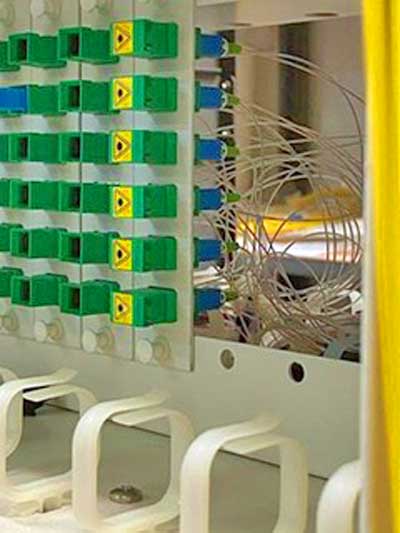
A: APC and UPC connectors are not compatible. APCs are
green, UPCs are blue. See https://foa.org/tech/ColCodes.htm To
test UPC connectors you would need a launch cable that is UPC on
the OTDR end and APC to to mate to an APC connectors. But if I
look behind these green APC mating adapters, I seem to see blue
connectors - blue is UPC not APC. (add photo)
VFL Works On Multimode And Singlemode
Q: Will a VFL for single mode work with a multi mode as
well?
A: Yes, a VFL works for either SM or MM fiber. Tight
buffer MM is no problem. On patchcords, the ability to see light
through the jacket of the cable depends on the color and
transparency of the plastic. On buffered fiber, it works well on
most 900 micron buffer fibers.
Campus Network Expansion
Q: Any advice for expanding a campus fiber optic network?
A: Here are some thoughts:
- Building
to building can more easily be done with indoor/outdoor
cable to get past the 50’ code limit for OSP cable.
- Many
campuses have ducts but they are often crowded. Microducts
or fabric ducts are often the solution even if you have to
pull out an older cable to pull in new microducts into one
old duct.
- Microducts
and blowing microcables are gaining lots of traction for
their practicality.
- Microducts
and microtrenching can be what we call “construction without
disruption.”
- We
are seeing more and more directional boring - works fine as
long as you know where other buried utilities are! Many
contractors need to learn more about underground location.
- People
are finally getting the idea about singlemode fiber - now
it’s probably cheaper than multimode.
- Passive
optical LANs can save money. Biggest advantage is the
upgrade from GPON to 10GPON is seamless - you can even run
both simultaneously, e.g. for a student system and a
faculty/research system.
- High
fiber count cables are tempting, but require special
handling and lots of manhole/handhole space.
- We’re
working with a Corning “Pioneer” (retired engineer) on
trying to educate installers about bend radius violations,
esp when pulling large fiber count cables.
- Most
installations shortchange manhole/handhole space.
- Aerial
is sometimes used. Lashing to a messenger is probably best.
We worked with a school in Canada last year trying to use
short lengths of ADSS and it was not cost effective nor was
their much applications support for short ADSS links.
- Line
of sight wireless (RF or optical) works across highways and
may be cheaper than construction for fiber.
March 2020
Troubleshooting
Links
Q: I have a run of 12 Strand single mode fiber from a
remote closet back to my main equipment room. I unpluged
it this morning to check another cable and when i plugged it
back i have lost communication with the remote closet. Can
you help me with some trouble shooting ideas. I have
already tried a new cable from the termination point back to the
switch but still no communication.
A: The first guess is that the fibers are not connected
correctly - transmitter to receiver. That’s the first thing to
check. The second possibility is dirt on the connector or in the
connector housing on the transmitter or receiver. Cleaning might
be the solution. Third and worst possibility is the connector
was damaged when being disconnected.
Q2: I ended up powering down the switch in the remote
closet and plugging the fiber in then powering it back up and it
picked up communication again. Strange ??
A: Nope, makes sense. Many new networks shut down unless
they have full duplex communications. If the link is broken, it
shuts down until reset.
~~~~~~~~~~
Cable Installation Guidelines
Q: I am trying to find information on the recommendations
regarding fiber underground in conduit. I am looking for
industry specific verbiage on the cumulative turn degrees before
you need a handhole or manhole. I believe it is 180 degree
cumulative but I can’t find it anywhere.
A: We’ve heard the 180 degree limit mentioned on some
conduit but not for fiber optics. For any fiber optic cable
pulling, the relevant issues are pulling tension and bend
radius.
We know of no specific standards or guidelines on conduit bends
for fiber optics. It has many factors, including conduit size
and type - there are many types, length of the pull, radius of
the bends, type of fiber optic cable and lubricants used, if
any. For the cable, there are thousands of fiber optic cable
designs that vary in diameter from ~3mm to ~30mm depending on
the type of cable and number of fibers, the stiffness of the
cable and the location and type of stiffer/strength members and
the method of installation - pulling or blowing/jetting. And for
locations as far North as you are, temperature can be an issue
as cable gets stiffer when colder!
For any given installation, corners are generally accommodated
by handholes/manholes and pulling done from handhole to handhole
with figure-8ed cable pulling techniques to prevent cable damage
by excessive tension or bending.
FOA has a section of our Guide on OSP construction: Outside
Plant Fiber Optic Cable Plant Construction and in that is
a section on OSP
installation. For specific cables or conduit runs, we’d
suggest talking to the application engineers at cable
manufacturers who can give specific advice.
~~~~~~~~~~~~~~~~
Minimum Link Length
Q: I have a question regarding minimum fiber optic
distances for horizontal runs. Is there a minimum distance for a
horizontal fiber optic run? Any information regarding this would
be greatly appreciated. Thank you for you help!
A: The answer to your question is for the most part no,
there is no minimum distance for a fiber optic link. For
example, fiber is used in offices, data centers, etc. sometimes
connecting equipment on a single rack. And there are many fiber
optic links used on platforms - aircraft, helicopters, ships,
etc. - and in command posts.
Most of the Ethernet standards are based on a 2m minimum, but
also most are defined by a maximum length. For multimode
systems, the max length is mainly a bandwidth issue, so shorter
links are no problem.
For singlemode links, the bandwidth is not an issue, it’s the
power budget, limited by the transmitter power and receiver
sensitivity, translated into the loss of the cable plant. But
for receivers, often they have not only a minimum input power
limited by their baseline noise but also a maximum power they
can have before saturating and causing high bit error rates. See
“Power
Budget” on this page in the FOA Guide. So if a singlemode
link is short, the receiver can be overloaded so an attenuator
is used at the receiver.
There is a secondary problem with singlemode systems,
reflectance. Reflections from connections can cause problems
with both transmitters and receivers, a topic covered in the
link given above. The reflectance problem can be solved with APC
connectors.
The FOA Guide
has many pages on links, networks, reflectance, testing, etc.
that you may find helpful.
~~~~~~~~~~~~~~~~~
PON Troubleshooting
Q: I have question about DBM IN GPON system with splitter
1:64. I spliced 2 fiber from splitter to customer going through
4 splicing points and when I measured the loss at the end
(customer) the #2 fiber was fine but the #1 fiber was down
12 dB. I checked the fiber with OTDR without splitter and it
looks fine. What you think is the problem?
A: You need to test the splitter itself to make sure all
ports are good.
February 2020
Fiber Flexibility and Longevity
Q:
When I think of glass, I think of a material that is not
very flexible. If you try to bend most glass, it will break. So
it is rather remarkable that you can bend a fiber and not
crack it, even though the strands are quite thin. Perhaps it's
not a good idea to bend fiber too sharply? I was talking to the
people who maintain the fiber network at the university here.
They tell me they have a problem when fiber gets to be about 15
years old, it will start to become brittle. If you flex it, it
will crack or break. Is this a common problem? How long can
fiber be expected to last before it becomes brittle? Is fiber
that is manufactured more recently have a longer life-span?
A: Fiber is quite flexible. One demo I did when I taught classes
was to walk up to a large window and push on it, telling
everyone to watch the reflections to see how the glass flexed. I
can flex quite a lot. Like most materials, as it gets smaller,
it can bend more easily because the stress is less across the
cross sectional area. Consider a bar of steel 1” in diameter
compared to a piano wire or banjo string. Most things break
because either they are overstressed or there is some impurity
in the material that focuses the stress and the crack propagates
from there. Ever cut glass? You scratch it and stress it along
the scratch line and its maps off - called cleaving - where the
stress concentrates along the induced fault. Fiber is extremely
low in impurities - a matter of how it’s made from raw
materials, not melted sand like most glass - that’s part of what
makes them have such low loss (efficient transmission) and high
strength. A glass fiber is much stronger than steel of the same
size. Corning
explains it here.
The brittleness of older fiber is due to the migration of
moisture up the cable into the glass. The H2O becomes the OH
radical which interacts with the glass to reduce its strength.
Most cable companies say their cable today protects the fiber
well enough that it should last 40 years, but where fiber is
terminated or spliced and exposed to the air, it can get brittle
and be hard to handle in 10 years or more. Older fiber had
shorter lifetimes simply because we learned to make fiber
coatings and cables better at sealing fiber from the ambient
atmosphere.
Fiber
Choice for LANs
Q: Many manufacturers or suppliers worldwide emphasize the
use of OM4 multimode optical fiber for the LAN. Does single-mode
fiber not provide greater bandwidth than multimode? Do they
imply that single mode optical fiber should only be used for
long distance applications and not in LAN environments?
A: Multimode fiber is acceptable for LANs up to 10
gigabits/second and up to 550 meters depending on the type of
fiber and Ethernet version. See this
page for a complete list of network specifications.Higher
versions of multimode fiber OM2-OM3-OM4 have higher bandwidth
capability. OM5 is a version of MO4 that also supports
wavelength division multiplexing with VCSEL sources in the
extended wavelength 850-950nm range. OM1 is a earlier fiber with
a different core size that has not been designed into new
systems for almost 20 years. LANs can use singlemode fiber for
all versions. Singlemode has longer distance capability (up to
40km) and virtually infinite bandwidth. See the singlemode
specification in the link above. Singlemode is also used in
passive optical LANs that can be much cheaper to build than
conventional networks. See this
page for information on optical LANs (OLANs)
including passive OLANs based on FTTH GPON technology.
Testing Pigtails
Q:
A customer said he said he would test 100 foot pigtails with
OTDR. I question that practice and think OLTS Tier 1 and
microscope test for defects,
A:
Pigtails do not have a connector on one end so that makes OTDR
testing more justifiable. Clean connector, mate to connector on
long reference cable, check connection and length. OLTS testing
would require using bare fiber adapter or temporary splice and
might not be very accurate.
What Is A Ring Network?
Q: If according to the TIA or ISO structured cabling
standards the fiber optic campus backbone must be
star-hierarchical type, how should a fiber optic "ring" be
built? to always ensure connectivity on a LAN?
A: A “ring” network consists of a series of links
connecting equipment (nodes) in series until the last one
connects back to the first. Since the links are communicate in
both directions, the network can still operate if any one
cabling link or equipment fails. Today, survivability is usually
ensured by using a “mesh” network; the architecture of data
centers, the Internet or phones. In addition to having a series
connection of nodes, there are other interconnections that
provide for multiple alternative paths. See Networks in the FOA
Guide. https://foa.org/tech/ref/appln/networks.html
Testing Samples Not Everything
Q: Instead of testing everything, how does one determine
how many fibers or components to test for a reasonable
statistical sampling?
A: The relevant term is AQL - acceptance quality limit -
a term that is used for statistical sampling for testing. Here
is a web page that explains it:
https://qualityinspection.org/what-is-the-aql/. Let testing and
inspection evolve. At first test thoroughly, but drop testing
anything that never fails, it’s a waste of time. Qualify vendors
and test trusted vendors less.
Fiber Lifetime
Q: I am often ask how long the fiber we are deploying
today will last or be useable , I typically say something like
it will last at least 20 years and that no one really knows how
long it can be used. What is the oldest fiber optic
network or longish segment that is still in production that you
know of?
A: Current cables are probably good for 40 years or so.
Today there is some fiber being used by telcos from the late
1980s and lots form the late 1990s and early 2000s. Lots of OPGW
(optical power ground wire) is in use up to 30 years old. Some
of this old fiber is being used at 10Gb//s. But remember that
fiber from 20 or 30 years ago may have limitations on bandwidth,
since both chromatic and polarization mode dispersion has been
reduced in newer fibers for higher speed networks. And spectral
attenuation of older fibers may be higher and have the water
peak at 1383nm that can affect wavelength-division multiplexing
systems. But the weak point may not be the cable or fiber, but
the splice and termination points where bare fibers may be
exposed to the elements. It's not uncommon to find these fibers
have become brittle and are hard to work with. What we always
tell people is if it’s working, leave it alone. If you want to
upgrade to higher bit rate systems, use fiber characterization
to determine if the fibers are capable of use at higher speeds.
Crossed Connections
Q: If a FO connector is crossed connected i.e Rx
connected Rx and Tx to Tx at both end, will it works?
I know in theory it will not due to light circuits arrangement,
but is there SFP in the market can tolerate that?
A: We do not know how a SFP could sense and change
polarity unless it had an optical switch inside the module. A
transmitter is a laser or LED and a receiver has a
photodetector. Unless one could have the devices change
function, changing polarity would be impossible.
Construction Near Underground Fiber
Q: What is the recommended distance for any new building
construction to build near underground fiber duct channel?
A: We do not know of any standards or codes related to
construction near fiber or other underground utilities. Common
sense dictates that one stay far enough away to prevent
accidental damage, so adding 5-6 meters(15-20ft) from the areas
of construction makes sense.
FTTH GPON
Q: Can you guide me some websites or pages where I can learn more about Gpon Technology please?
A: FOA Guide has a big section on FTTH and OLANs using GPON technology. Follow those links,
Splice
Loss
Q:
We are installing 216 fiber aerial cable for 12km with 2
splicing points. We use 3 different fusion machines and they
report that all splices are 0.00db. But when we check using OTDR
we get above 0.04db. The question is how can we get below 0.04db
splicing loss?
A: The loss results from both fusion splicers and OTDRs
are estimates, with considerable uncertainty. The splicing
machines estimate based on the optical images of the fibers. The
OTDR estimates loss based on fiber backscatter and may give
significant differences depending on the direction of test. The
differences you quote are within the uncertainty of the two
instruments.
Cheating
On Link Length
Q: I have a fiber run for a camera starts at location A to
location B it is 467 feet. Location B jumpers through to
location C which is 2060 ft at location C. Transceivers areSFPs
ONLY GOOD UP TO 1800 ft, but this company only has a multimode
system. Is there something i can do to make this work?
A: It might work as is, since electronics are usually
quoted with conservative specs and will work farther than
specified most of the time. If you have several SFPs, test the
output power to see if it exceeds specs and choose the 2 ones
with highest power. If that still doesn’t work, contact SFP
manufacturers for higher power units.
Pulling Cable
Q: I’m having trouble finding much information on the
matter. What type of swivel should be used to pull fiber and
what would be the correct way to pull armored fiber.
A: Start on the FOA Guide here and go here for
types of swivel pulling eyes. with https://foa.org/tech/ref/OSP_Construction/Underground_Installation.html
and here are sources https://www.comstarsupply.com/cable-pulling/swivels.html
It’s not common to “pull” armored cable since it’s designed for
direct burial, but a kellums
grip on the jacket will generally work.
Errors In A Data Link
Q: What is the significance of bit error, and what is the
acceptable rate for communications and submersible vehicles?
A: On any data link, there is an acceptable amount of
error that can be tolerated. If it’s a digital voice link, a BER
10E-6 (1 error in 1million bits) is acceptable without affecting
voice quality. If it’s a link to your bank, the typical standard
is a million times higher (10E-12). Link protocols usually have
ways to determine BER, like attaching a checksum to the end of a
data packet and having it checked at the receiving end. If a
error is suspected, the packet will be discarded and
retransmitted. Here is a tutorial
on BER and an explanation
of errors in a a fiber optic link.
Math of Fiber Optics
Q: Do you by any chance recommend any books as an
introduction to understand the mathematics of fiber optics?
Fiber optics confuses me, particularly how so much data
can travel over light without interfering with each other,
A: If you are interested in information theory, that’s
really covered by Claude Shannon at Bell Labs 70 years ago.
That’s actually pretty simple. Shannon proved that digital data
was best and how much data could be transmitted with a given
amount of bandwidth (Read
more). There are several levels of math associated with
fiber optics. The real theoretical basis is probably in dozens
of books but I like these:
Top Level: Gerd
Keiser
Middle Level: Jeff
Hecht.
If you are interested in non-math explanations, the FOA website
has that:
Fiber
Optic Datalinks
Bandwidth: https://foa.org/tech/ref/OSP/fiber.html#dispersion
Wavelength-Division
Multiplexing
For testing math (dB loss, metrology, etc.) these links or the FOA
book on Testing
Metrology
and Fiber Optics
The
Math of Insertion Loss Testing - Reference Methods
APC Connectors
Q: Why NOT make the use of APC connectors the new standard
for all adds, moves and changes to any campus, MDU or similar
application using single mode cable?
A: There is absolutely no reason not to use APC
connectors other than the cost is higher and one must be careful
if they are used in a cable plant that also has PCs or UPCs
because they are incompatible. We recommend them all the time
for short links like data centers, passive optical LANs and FTTH
where runs of singlemode fiber are short. In fact they are very
common in these networks today.
GPON
Q What is normal Range for good power in an FTTH fiber?
A: The GPON specification for downstream power from the
OLT is OLT transmitter power should be 0 to +6dBm and link
attenuation in the range of 13 to 28dB, which says receiver
power the ONT must be a maximum of 13 dB less than +6dBm or
-7dBm and a minimum of 28 dB less than 0dBm or -28dBm, so -7 to
-28dBm at the receiver.
Upstream, the similar calculation is ONT transmitter -4 to
+2dBm and the receive power at theOLT is -11 to
-32dBm.
See http://thefoa.org/tech/ref/appln/FTTH-PON.html for the full
specifications for GPON.
Testing
Cable Before Installation
Q:
Does the FOA publish a standard for assessing single-mode
fiber optic cables, prior to use on a specific project?
A: The ANSI/NECA/FOA-301 fiber optic installation
standard covers this in Section 4.1. It recommends visual
inspection and testing if there is any suspicion of damage to
the cable. Many contractors will test a couple of fibers with an
OTDR before installing any cable, just for assurance. It
requires an OTDR with a pigtail launch cable and a mechanical
splice.
Cable Bend Radius
Q:
We are working on project where we need to know difference
between short term and long term bend radius for fiber optic
cable?
A: The bend radius for cables is generally specified
under two conditions - under stress, e. g. when being pulled, it
is a radius 20 times the cable diameter. Relaxed, after
installation, it is a radius 10 times the cable diameter. The
relaxed specification, 10X, is considered a long term
specification. Some of the new high fiber count cables have
different specifications, sometimes 15X or 20X under either
condition. Check with the manufacturer for their specific cable.
OTDR
Resolution
Q: If testing a 40KM link with 1KM launch and
receive cords should I be able to see the connector and cassette
splice on each side? My OTDR setup is at 64KM, 300ns pulse and
10 second test at 1310/1550/1625. It shows as a single event so
far but with the pulse width at 300ns won’t that combine the
events into one event during analysis?
A: You will not be able to resolve a connector and splice
close together, especially on a long link like that. 300ns is
almost 60m pulse width! You will see an even of the splice and
connector combined.
Transmission
Wavelength Compatibility
Q: We are looking at the specs for two devices, A
and B. The spec sheet of Device A lists it is capable of MM in
850nm wavelength. The spec sheet of Device B lists it can do MM
at 1300nm. If I connect these devices via MM patch cord, what is
the impact due to different wavelengths? Will the transmission
suffer significant loss or since both are multimode, wavelength
is irrelevant?
A: Fiber works at either wavelength, but transceivers do
not. The attenuation rate for MM fiber is ~3dB/km at 850nm but
only ~1dB/km at 1300nm. But 850nm receivers use silicon
photodiodes while 1300 nm receivers use InGaAs. The 1300
detectors are not sensitive at 850nm and vice versa. So while
the fiber works fine, the electronics do not. They should only
be used with like devices.
Older
questions are now available here on the FOA Guide.
RETURN
TO INDEX
FOA
"Quickstart Guides"
In our
continuing quest to help people understand how to test fiber
optic cable plants and communications systems, we've created two
more "QuickStart Guides to Fiber Optic Testing." They are
simple, step-by-step guides on how to test fiber optic cable
plants, patchcords or single cables using insertion loss or OTDR
techniques and optical power from transceivers. It's as
straightforward as it can get - what equipment do you need, what
are the procedures for testing, options in implementing the
test, measurement errors and documenting the results.
It can't get much simpler.
Send anybody you know who needs to know about fiber optic
testing here to learn how it's done in a few minutes.
Testing
Fiber Optic Cable Plants And Patchcords
Testing
Fiber Optic Cable Plants With An OTDR
Testing
Optical Power In Communications Systems
RETURN
TO INDEX
-
FOA
Tech Topics -
A
Fiber Optic Tester In Your Pocket? (See the video on
 )
)
Yes!
The camera in your old cell phone is sensitive to infrared light
- lots more than your eye - and can detect light in an optical
fiber or from a transmitter. Chris Hillyer,CFOT/CFOS/I,
Master Instructor, Northern California Sound & Communication
JATC brought this to our attention.
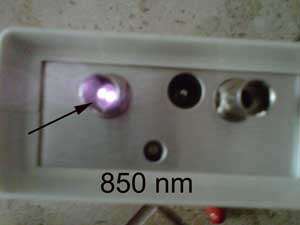
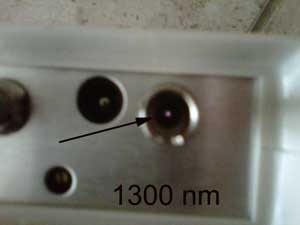
If
you have an old cell phone, try it. Our experience is that older
cell phone cameras have better sensitivity at IR wavelengths
than newer phones, so you may want to toss that old flip phone
into the toolbox.
RETURN
TO INDEX
Product
News
YOKOGAWA OTDR Has Extended range, High Resolution And Multitasking

One OTDR manufacturer you don't hear as much about is YOKOGAWA
(formerly ANDO) which is too bad - they make some of the best
OTDRs, exemplified by this new model AQ7280. Need long range -
how about 50dB. High resolution - 0.6m dead zone. Like touch
screens, but for some functions want hard buttons, it's got
that. Options for VFL, microscope, light source and power meter,
etc. - it has that too.
But the unique aspect of the YOKOGAWA AQ7280 is it offers
multitasking - you can let do a trace with long averages while
you inspect connectors, make power readings, use the VFL or
other functions.
More
info on the YOKOGAWA AQ7280.
FOA
thanks Yokogawa for a gift of an OTDR to use for R&D and
teaching!
Have
you read the FOA
pages on cleaning?
- RETURN
TO INDEX
|







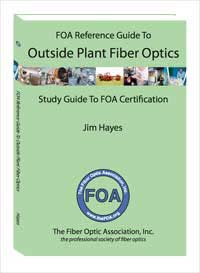


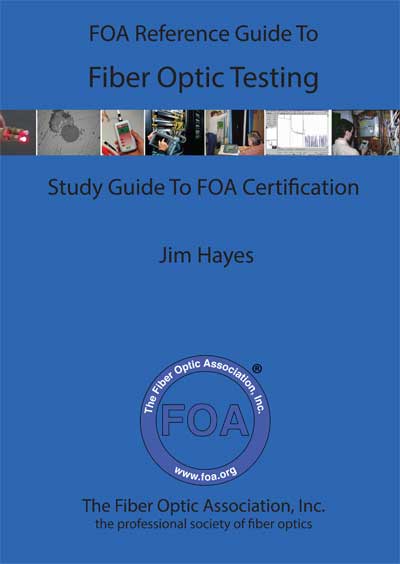















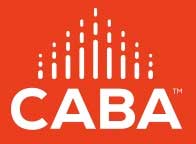






















 .
.


























